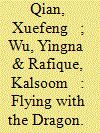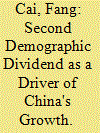|
|
|
Sort Order |
|
|
|
Items / Page
|
|
|
|
|
|
|
| Srl | Item |
| 1 |
ID:
175575


|
|
|
|
|
| Summary/Abstract |
This paper studies the effect of high‐speed rail (HSR) on urban economic growth using a panel data comprising 285 Chinese cities in 2007–2017. Combining the endogenous growth model with a difference‐in‐difference analysis, we extend the horse‐mass theory to explain how China may use HSR to avoid the so‐called middle‐income trap. The paper also examines the efficient boundaries of HSR and simultaneously studies HSR time–space compression as well as the city neighboring effects on economic growth. It is found that HSR's efficient boundaries are within the range of 200–1,200 km for provincial capitals and 50–300 km for prefecture‐level cities. HSR stimulates economic growth by approximately 0.6 percent, and the neighboring effect accounts for one‐quarter of economic growth. Three policy implications are drawn: (i) China needs to further reduce the travel times between the inland provincial cities and Beijing, Shanghai or Guangzhou; (ii) China should build a denser HSR network to maximize its economic impact on the vast majority of cities; (iii) China needs to develop some powerful economic growth centers in the inland areas to lead the development of their neighboring cities.
|
|
|
|
|
|
|
|
|
|
|
|
|
|
|
|
| 2 |
ID:
175574


|
|
|
|
|
| Summary/Abstract |
This paper empirically investigates the impact of China's outward foreign direct investment (OFDI) on its export sophistication. Using a provincial‐level panel dataset and applying fixed effects and instrumental variable regression techniques, the study finds that, on average, OFDI has no significant impact on China's export sophistication. However, after the full sample is divided into different regions, the study finds that OFDI has a positive and significant impact on export sophistication in the developed coastal region, but no such impact is observed in the less developed inland regions. Further investigation using a panel threshold model reveals that only when GDP, per capita GDP, human capital, and the research and development intensity of a home economy reach a certain level can OFDI promote export sophistication. The findings suggest that accelerating eco nomic development and increasing absorptive capacity can facilitate the contribution of OFDI to China's export sophistication.
|
|
|
|
|
|
|
|
|
|
|
|
|
|
|
|
| 3 |
ID:
175571


|
|
|
|
|
| Summary/Abstract |
As a large trading nation, China competes with importing countries’ domestic and third‐country markets but also creates growth opportunities for exporters. Most studies on China trade shocks or “China shocks” focuse on the impacts of import competition on developed economies. The present paper complements research on China shocks by exploring the other side of the trade exposure to China – China as the largest importer, rather than as an exporter. We analyze the effects of export expansion into China on the local labor markets of the exporting developing countries for the years 1992 to 2018. Using detailed export and employment data, we estimate employment pattern variations in manufacturing industries with exports from other developing countries as instruments for export exposure. We find that the increase in trade exposure to China in the world economy has caused extensive job gains in manufacturing industries in developing countries that were exporters. On average, our estimations show that this trade exposure created approximately 1.5 million additional jobs from 1992 to 2018, which made an important contribution to manufacturing industries in developing countries. Our empirical analysis also shows that trade had stabilizing effects on employment in the countries in our sample generally.
|
|
|
|
|
|
|
|
|
|
|
|
|
|
|
|
| 4 |
ID:
175576


|
|
|
|
|
| Summary/Abstract |
The development of information and communications technology (ICT), particularly the Internet, has reduced trade costs. However, it remains unclear whether these reduced costs are reflected in the “extensive margins” of firms’ exports (which refer to the probability of firms exporting) or the “intensive margins” (which refer to the value of firms’ export). To test this, we used the concepts of information cost and binary margins, an augmented trade model of firm heterogeneity, a two‐stage Heckman estimation, and data from the World Bank Enterprise Survey of Chinese firms in 2012. The results revealed that reduced trade costs from the use of ICT were positively related to extensive margins but that the connection with intensive margins was not significant. The results lead to the conclusion that reduced information costs related to a firm's exporting behavior were primarily reflected in variable trade costs. This study offers theoretical and empirical evidence for China's policies towards the Internet, which are relevant for the export of manufactured goods. The government should encourage the use of ICT to enhance firms’ export opportunities while facing current trade policy uncertainty.
|
|
|
|
|
|
|
|
|
|
|
|
|
|
|
|
| 5 |
ID:
175573


|
|
|
|
|
| Summary/Abstract |
This paper investigates the effects of the renminbi (RMB) exchange rate on trade prices and volumes in selected Belt and Road Initiative (BRI) countries in comparison with the effects of the US dollar. The stylized facts show that the RMB is underused in bilateral trade with selected BRI countries where intermediate goods dominate. By estimating the level of exchange rate pass‐through and trade volume elasticity, we find that the RMB is significantly correlated with the volume of imports in the sample countries, predicted by the producer currency pricing (PCP) paradigm. We also regroup intermediate and final goods between China and the BRI countries. The evidence shows that dollar fluctuation affects export volumes, reflecting the role of the US as a final goods destination, whereas the RMB exerts a significant impact on the volume of intermediate goods imported from China to the sample countries due to China's important position in global value chains.
|
|
|
|
|
|
|
|
|
|
|
|
|
|
|
|
| 6 |
ID:
175572


|
|
|
|
|
| Summary/Abstract |
As China's demographic transition enters a new stage, the “first demographic dividend” – the economic advantage resulting from demographic changes in recent decades – is bound to disappear permanently. China's future development will be characterized by an aging population. The “second demographic dividend” refers to new sources of economic growth derived from this later population change. This paper reveals major constraints caused by aging in China, which is characterized by a tendency to grow old before becoming rich. As the population ages, human capital improvement slows, labor force participation declines and consumption power reduces. This paper suggests taking advantage of a population “echo effect” to improve human capital at all ages, to enhance workers’ ability to benefit from employment, and to improve the labor participation rate of the elderly, which in turn would increase the income and social security of the aged. These measures are conducive to future economic growth and to the cultivation of the second demographic dividend.
|
|
|
|
|
|
|
|
|
|
|
|
|
|
|
|
|
|
|
|
|